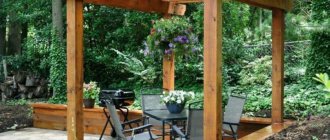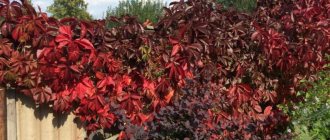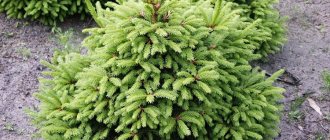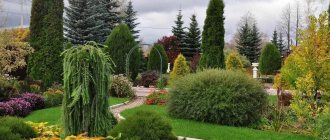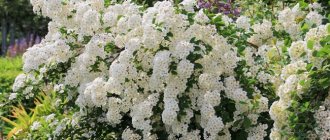Viburnum is a very ornamental plant that is liked by many. In spring it is densely decorated with beautiful white inflorescences, and in August bright red fruits appear, which are also very useful for colds. But viburnum does not take root everywhere. Sometimes you have to change several places for her to take over and begin to actively grow and develop. What plants does viburnum go with? is it best and where should I plant it? Let's try to figure it out.
Landscape techniques: how to beautifully serve viburnum Buldenezh
When the ornamental shrub, viburnum buldenezh, blooms, and this happens at the end of May, a snowy winter comes to mind.
Large inflorescences, spherical in shape and reminiscent of lumps of snow, cling to the branches so thickly that it is appropriate to compare the plant with a snow-covered one. They reach 20 cm in diameter. Opened flowers that have just begun to bloom have a greenish color, but change it to dazzling white and become like snow. Due to the similarity of the inflorescences to a snowball, a ball of snow, the plant received the Latin name Viburnum Boule de Neige . Viburnum buldenezh blooms profusely. If the plant is properly cared for, the “snow globes” set thickly and grow large.
Viburnum roseum and buldenezh differences
Popular types of viburnum in landscape design are the common buldenezh roseum and the decorative one with slightly larger inflorescences and double flowers.
The inflorescences of roseum, like other types of viburnum, at the beginning of flowering have a greenish color, which changes to white as it blooms. But by the end of flowering, the flowers of viburnum roseum acquire a pinkish tint, in contrast to the snow-white inflorescences of decorative buldenezh.
Both viburnum flowers are used to collect white, spectacular bouquets, complement flower arrangements with buldenezh balls, and use shrubs in landscape design.
Viburnum buldenezh decorative and ordinary
Both varieties are similar in appearance and growth.
Viburnum variety (Latin Roseum)
Bred in France by Lemoine. It is durable (lifespan up to 80 years). Viburnum reaches its maximum height (up to 5 m, although there are plants higher than 6 m) in 5-10 years. The annual growth of the shrub is 0.3 m in height and 0.4 m in width. The spherical inflorescences of the common viburnum reach up to 10 cm in diameter. Their flowers are sterile due to the absence of a pistil, stamens and inflorescence in appearance they resemble a snow globe. At first, the greenish inflorescences then turn white and remain that way throughout flowering for 25-35 days, only turning pink when they fade.
Buldenezh decorative
The diameter of the inflorescences of the decorative viburnum buldenezh is larger - 12-15 cm, flowering lasts about 20 days. Compared to ordinary viburnum, it has larger double flowers, but loses in winter hardiness.
Medicinal properties
Ordinary viburnum has long been famous for its healing properties, providing an antipyretic, tonic and restorative effect on the human body. However, Buldenezh is not used in folk medicine for precisely these purposes, since the bush does not have those very healing red berries.
For cosmetic purposes, only tinctures from the flowers of the plant and decoctions from the bark of the bush can be used, because, according to reviews, they can soften the skin, tone and improve its appearance, which is especially useful for facial care. It is not worth experimenting with other areas of application of Buldenezh viburnum, since it is difficult to predict the reaction of the human body in each individual case.
With the comparative ease of caring for the shrub, it will always delight you with its excellent appearance and large white flowers, which perfectly complement the landscape of any garden plot.
In garden design (photo)
In Europe, viburnum buldenezh has been used in landscape design for more than 4 centuries.
With the appearance of the snow beauty, rich aristocrats began to plant the plant in their gardens as a tapeworm, create garden compositions , and completely plant the garden area with the snow-white flowering plant. Viburnum is still considered an aristocratic crop , although anyone can plant the shrub.
A single viburnum bush and a group of plants look beautiful near the house . The beauty of the flowering shrub is emphasized by a neatly trimmed lawn; its snow-white flowers are set off by bright flower beds laid out around the plant. In summer cottages, viburnum bushes are used to create green hedges that look impressive throughout the year.
By shortening the young shoots, the plant is given a dome-shaped shape, the tops of the bushes are trimmed so that the hedge from the group of plants has an even horizontal top, and the bush is formed into a tree.
Gardeners immediately determine the plant’s place in the landscape; often viburnum is planted alone, and early flowers under the bush are changed every year - snowdrops, tulips, daffodils . They fade before the buldenezh begins to bloom and do not draw attention to themselves.
Over the years, the branches of the bush droop, and the plant begins to resemble a weeping willow. If there is a pond on the site, perennial shrubs are planted near the water, like willow. Benches and benches for relaxation are installed in the shade of a single adult plant or a group of buldenezh.
Combination with other plants
Garden mock orange, Persian and purple common lilac, spirea, barberry, hydrangea - this is an incomplete list of plants that go well with buldenezh. Flowering shrubs emphasize the lush appearance and beauty of viburnum leaves. The dark greenery of coniferous species, the white trunks of birch trees, the feathers of rowan trees, the covers of linden trees in a group planting create the image of a magical forest, with viburnum on the sunny edge. In such an improvised forest, the bulldog plays the role of a “borderline” plant.
Often designers plant viburnum, bulldonezh and barberry nearby. A unique garden of shrubs looks good next to gazebos and recreation areas, in the garden area. Such a neighborhood brings harmony and positive energy. The modern trend in design - eco, aimed at studying the energy of each plant, uses buldenezh as a source of inexhaustible energy.
Viburnum flowers are also in demand among florists. They can stand in a vase for a long time without losing their freshness and beauty. And you can combine them in a bouquet with absolutely any flowers. White balls will become an unusual backdrop and will help to play advantageously on the contrast of the color and shape of the plants.
Red viburnum and its use in landscape design.
Red viburnum is an iconic plant that will also fit perfectly into almost any landscape design!
Viburnum is traditionally used in landscape design and is respected by designers and garden owners for its decorative and medicinal qualities. Since ancient times, the tree has been considered a wedding tree, protecting the young from hardships and adversity. Young unmarried girls embroidered its fruits and leaves on clothes and towels in order to give them to their betrothed.
Viburnum branches were also present in the form of dough decorations on wedding pies and loaves. But this is only a small part of those traditions that were once related to the wonderful tree - viburnum. There are many more of them and to this day many of them are held in high esteem.
Viburnum: wood features
Viburnum resembles a bush more than a tree and belongs to the Adoxaceae family. Native to North Africa, America and Eurasia. Represented by more than 200 species, most of which are successfully used for landscaping. But it is the ordinary viburnum with red fruits and a white-pink cloud of weightless color that is most often used for decoration for one simple reason - this species is considered to be a true viburnum, and stereotypes are not so easy to break.
Common viburnum is most often a shrub, and very rarely a tree. It grows from 1.5 to 4 meters and is distinguished by grey-brown bark. The leaves are round in shape and dark green in color.
The main feature of the shrub is flowers, white or delicate pink, grouped at the tops of branches into inflorescences. At the same time, the sterile flowers are located at the edges, as if hiding behind them small flowers on compact pedicels. The plant blooms from May to July - flowers appear, which are replaced by red fruits, which finally ripen by the beginning of autumn. The shape of the berries can be oval or round, the pulp has a viscous tart taste, which noticeably softens after the first frost.
The bark, fruits and flowers of the tree are used in medicine; the plant is actively used to decorate gardens, parks, and city squares.
Where to plant viburnum: choosing a place
The plant feels good in partial shade, but gardeners advise planting the tree in areas well lit by the sun. The decorative qualities of the shrub will only increase in such conditions. As for the soil, the optimal acidity should range between 5.5 and 6.5. Viburnum prefers plenty of moisture, so planting the tree near a pond, lake or reservoir is a good idea.
The rhizome of the plant is well developed and is responsible for strengthening the soil. That is why it would be logical to plant viburnum in areas with slopes and slopes to strengthen them. Again, it is important to remember the plant's love of moisture.
It is better to plant viburnum either in spring or autumn. The suitable size of the planting hole is 50 by 50 cm. A mixture of peat, phosphorus, potassium and nitrogen in the planting hole will stimulate plant growth. When planting, you need to keep a distance between viburnums - from 1.5 to 2 meters.
Meaning
Viburnum roseum is a plant that can be found almost everywhere. The main condition for its growth is constantly moist soil. That is why it is often used for decorative purposes to decorate embankments, gardens and parks, as well as other corners of nature in noisy cities.
This shrub has become widespread as a summer decoration. Its spreading crown, snow-white flowers, scarlet fruits - all this is highly valued by people who have at least once seen this plant.
Viburnum fills the second tier in the same ecosystem with deciduous and coniferous trees. It is very often planted as a hedge. It will be dense and freely growing.
The use of viburnum in the design of plots
The dense crown of red viburnum will be a suitable option for decorating a hedge. The bush will be able to provide reliable protection from the wind and hide it from the views of curious strangers. Viburnum "Roseum" with amazing flowers will be an ideal option for solitary plantings, and will also look good as a background for flower beds using herbaceous perennials.
Dwarf viburnum shrubs, such as “Compactum” and “Nanum”, will be a good solution for creating a garden with plants in containers and pots, as well as for creating a decorative rock garden.
The plant goes well with shrubs and flowers of different types and types. Viburnum looks especially impressive against the background of dark and massive conifers, both trees and shrubs, emphasizing its sophistication and decorative elegance. Viburnum planted near other shrubs will become a haven for birds and small insects.
For decorating flower beds and flower beds, the viburnum variety “Roseum” is most suitable as a background shrub. The flowers of the bush will harmonize with compositions of any plan and shade. Nice, viburnum will look in its place near the porch of the house or under the window.
Viburnum buldenezh in landscape design: white balls of snow in the spring garden
We will send the material by email
Even during the period of Catherine II, an ornamental plant (Viburnum Boule de Neige), which translated means a snow globe, was brought to the territory of Russia, especially for decorating royal gardens and greenhouses. And this miracle tree turned out to be Viburnum buldenezh; it looks perfect in landscape design. Thin branches, under the weight of buds, descend to the very ground, creating the impression of a fairy tale, where in late spring the green tree was covered with snowballs.
After that, they began to plant it in the courtyards and personal plots of aristocrats, and this plant has not lost its popularity to this day. We'll tell you what kind of plant this is, how to care for it and what to combine it with in the garden.
Features and Specifications
Viburnum Buldenezh can grow up to 5 meters high, and its white inflorescences, which resemble snow globes, reach 20 cm in diameter. With proper care throughout the year, the plant grows by 30-40 cm. This tree is long-lived, from 50 to 80 years. If you compare it with red viburnum, buldenezh has large buds and does not bear fruit.
The snow beauty blooms throughout the month. Its thin branches, which fall like a weeping willow under the weight of buds, are covered with carved leaves of a soft green hue, turning burgundy by autumn.
Varieties
There are many decorative varieties of viburnum Buldenezh; we list the most popular:
- Ordinary . This species does not produce fruit; the flowers do not have a pistil or stamen. The plant has good tolerance to pruning and modeling, for which it has received recognition from many designers.
- Decorative . Compared to the first option, the bush of this variety is slightly smaller.
- Let's get pink . This species has an unusual inflorescence, in the form of terry balls. At the beginning of flowering, when the buds are just opening, the balls have a green tint. After a little time they turn white and turn pink towards the beginning of wilting.
It differs from other varieties in good frost resistance. In autumn, the foliage turns yellow, red, and stays on the branches for a long time, until frost.
What to combine with
The beauty of the plant is highlighted by trees with dark foliage and conifers - thuja, spruce, pine . Viburnum with white inflorescences is harmoniously complemented by simultaneously blooming lilac bushes of different tones , from light lilac to dark saturated Persian lilacs. Viburnum looks good next to the delicate garden mock orange and bright colorful hydrangea. And white paniculata hydrangea supports the concept of a white garden. Both during flowering and after, when the beauty of the viburnum bush is created only by the foliage - green after flowering and bright in the fall, a good neighbor is Thunberg barberry.
The beauty of the plant benefits from its proximity to white birches, rowan trees, maples, lindens, and oaks .
Growing viburnum
The life form of viburnum is a shrub, less often a tree. The height of the plant can vary between 1.5–4 m. The bark on the shoots is brownish-gray; The foliage is beautiful, dark green, carved, reminiscent of maple in shape. By autumn, the leaf blades turn reddish.
Flowering begins in May and ends in July. Immediately after it, fruit ovaries form on the hands. The berries ripen by the beginning of autumn, but the taste remains tart . The fruits remain on the branches even after the arrival of winter - during this period they acquire a pronounced sweetness and lose their tartness. Scarlet berries dusted with snow look very interesting in various landscape compositions.
A well-lit place is best suited for planting viburnum, although it can also grow in light shade. The soil on the site should be loose, without stagnant water. To ensure high yields, it is advisable to plant 2-3 plants at once, since they cross-pollinate. They are placed at a distance of 2.5–3.5 m from each other. Planting is carried out in the spring (before buds open) or in the fall (from the massive fall of leaves to the first frost).
Three-year-old specimens take root best in a new place. A place on the site for them must be prepared in advance. About six months before planting, the area is cleared of weeds and other debris. The soil is dug up to a depth of 40 cm, then 10 kg of peat and 10 kg of manure (preferably rotted) are added to each 1 m² and the soil is cultivated again to a depth of 20 cm.
Planting process:
- After 2 weeks, a small mound is formed in the central part of the pit.
- The roots of the seedling are placed on the embankment, carefully spreading them along the entire perimeter of the hole.
- After this, fill the hole with soil, making sure that the root collar is buried 5 cm.
- Next, the tree trunk circle is compacted and 10–20 liters of water are added under the root, depending on weather conditions. The goal is for the soil to be moistened to a depth of 40 cm.
- After moisture has been absorbed and the soil has partially settled, the tree trunk circle is mulched with peat mixed with sawdust in a 1:1 ratio to a height of 10 cm.
Its history is long.
Garden historians believe that the decorative form of viburnum with sterile flowers collected in thick clumps first appeared in medieval France. It is believed to have arisen naturally many centuries ago, and gradually spread to gardens. Also, a surprisingly accurate name has long been assigned to it - Buldenezh “snowball”, reflecting its main attraction - dazzling white spherical inflorescences.
It differed from ordinary viburnum in the complete absence of any reproductive organs (stamens and pistils), which made its seed reproduction impossible. But the gardeners of medieval Europe, it turns out, were literate enough to master the vegetative propagation of shrubs. So it gradually scattered throughout Europe, and no later than the 18th century it ended up within the Russian Empire.
The bush of this viburnum itself, when it does not bloom, is no different from wild plants. But there is a huge difference in flowering. In a natural species, the inflorescence looks like a flat umbrella, in the center of which there are small fertile flowers, and on the periphery there are larger, sterile ones, which, according to botanists, are just bait for pollinating insects. In Buldenezh there are no fertile flowers, but sterile ones densely cling to each other, forming dense spherical inflorescences up to 10 cm in diameter. At first they bloom greenish-white, then snow-white. Flowering usually begins at the end of May and often ends in July.
Viburnum care
The culture in question is very attractive to gardeners and landscape designers because of its unpretentiousness. It will require minimal care.
It consists of performing the following agrotechnical activities:
- Watering is carried out once a week, 10 liters of water should be used for each young plant that does not bear fruit, and 30–40 liters for each fruit-bearing plant.
- Loosening - carried out after each watering and rain to a depth of at least 5 cm.
- Mulching - new mulch is laid under the viburnum in the spring, when the soil is moist and loose. Use a mixture of sawdust and peat (1:1). The layer thickness should be at least 10 cm. In the fall, add a little more mulch so that the layer reaches 15 cm.
- Fertilizer application is carried out from the 2nd year of plant life on the site. In the spring, before the buds open, 1 bucket of rotted manure is added to each bush. It is carefully distributed in the tree trunk circle. Before flowering, add 500 g of wood ash to each specimen. This feeding can be done every 20–30 days. In the fall, the same manipulation with the addition of organic matter is repeated as in the spring.
- Pruning is carried out in spring (formative) and autumn (sanitary).
Disease and pest control
Viburnum "Buldenezh" quite often becomes a target for a variety of pests. In most cases, you have to fight the viburnum leaf beetle, as well as the viburnum aphid, called the leaf roller. You definitely need to get rid of these insects, otherwise the bush will quickly end up almost completely gnawed off. As a preventive measure in the spring, before the buds begin to bloom, viburnum is treated with special insecticides. These drugs will also help you cope with scale insects. Aphids are driven away from the bush by spraying with a soap solution, and they are repelled by scattering wood ash in the circle around the trunk.
If the leaves are covered with a whitish coating, then the reasons may be infection with powdery mildew. Treatment is carried out using a soap-soda solution. To prepare it, about 100 grams of soda are added to 20 liters of soapy water. Shrubs are processed every week. The culture will be able to fully recover in approximately 2 weeks. As a preventative measure in the spring, you can also treat viburnum with tobacco, garlic or onion solutions. If the viburnum "Buldenezh" does not bloom, then perhaps the problem is that the bush is too thick, and it needs to be pruned. The leaves of the crop turn yellow, usually due to violation of irrigation conditions.
Features of application in landscape design
Viburnum looks good planted either alone or in combination with other groups of plants. It can also be used to create a hedge. With the help of shrubs, you can arrange a flowerbed that will divide the territory into zones, or shade a place to relax.
Flowerbed with viburnum
The flowerbed can be formed at the discretion of the gardener. An interesting option is to shade a place to rest with viburnum, as shown in the figure below:
To create such a composition, bushes are planted closer. A distance of approximately 1.5 m is left between them. They are formed into a pyramid: for this purpose, they take special frames, put them on plants and trim the branches in the spring. In the fall, sanitary pruning is carried out and the results are monitored. Then every year they make sure that the branches grow in the correct, initially formed direction.
An island with viburnum and spruce will harmoniously fit into the landscape of a garden or yard. In addition to them, you can place rose and rosehip bushes, moisture-loving, shade-tolerant flowers in the flowerbed. When creating such a composition, you should calculate the distance between the vegetation in advance, since spruce and viburnum will require a fairly large feeding area. Between them you should leave a step of approximately 3.5 m.
When forming a viburnum bush in the first year, approximately 5–7 shoots are left, all the rest are cut out. Skeletal branches are shortened by 1/3 of the length. In the autumn, sprouted root shoots are removed so that the vegetation does not take up too much space. In the spring, 2 good shoots are left on each annual growth, the rest are cut out. The root shoots and branches growing inside the bush are also removed.
Every 6–8 years, viburnum bushes are rejuvenated: for this, 3 powerful basal shoots are left in the fall, the rest are removed. In spring, 1/3 of the old branches are cut out. They do the same for another 2 years.
Viburnum on a trunk
It is more difficult to form a trunk than a bush, due to the peculiarity of viburnum to produce a large amount of basal shoots. To carry out the task, a year after planting, the strongest, vertically growing shoot is selected. All others are deleted. A supporting stake is dug in next to the trunk and a garter is made.
When forming a trunk, all root shoots are cut off throughout the year so that there is no interference with the development of the main trunk.
Other methods of reproduction
By layering
Vertical layering is an easy way to propagate viburnum. In the fall, the lower shoots with several buds of the selected bushes are shortened and each of them is hilled in half.
Next spring, new 15-centimeter growths will form from the existing buds, which will again spud by half. In the fall they will already form roots. They are cut off from the old bush and planted in the soil for growing until the next season. And next spring they are already moving into open ground to a permanent place.
Viburnum has the ability to form additional roots well on shoots. This ability is used when choosing the method of propagation by horizontal layering, in which the shoots are folded back, pinned with paper clips or spikes and moistened. When shoots 13 cm high grow from the buds, they are hilled up by a third. As the shoots grow, the height of the hilling increases almost to the height of the shoots. In the fall, cuttings are dug up, separated from the old mother plant and divided into independent bushes, and then planted in the soil.
If the plant is the only specimen, it is propagated in greenhouses using the air layering method. This rather labor-intensive method involves pulling the shoot with wire and covering it with sphagnum moss. The sprout is moistened daily, treated with a growth stimulator and wrapped in plastic film. As soon as the root system is formed, the cuttings are cut off from a single specimen and planted separately.
Basal shoots
The fastest way to propagate a bush is by root shoots. At the end of spring, the base of the shoots should be tied with soft wire. This will significantly speed up their root formation. Then they are covered with humus. During the summer, hilling is carried out approximately 3 times, so that the mound is at least 20 cm in height by autumn. In the subsequent spring period, the shoots are separated from the mother bush and planted as an independent plant.
Dividing the bush
This technique is used to transplant a plant or a very valuable species. The advantage is low labor intensity, but the disadvantage is the limited number of seedlings obtained. This method makes it possible to obtain in spring or autumn, when dividing one young bush, no more than 3 daughter plants with their own part of the roots and several growth buds for renewal.
Kalina Buldenezh: 30 options in landscape design to bookmarks 9
The decorative species buldenezh was bred on the basis of the common viburnum specifically for creating landscape design. The beautiful white balls of viburnum inflorescences resemble snowballs. And when they fall off, a white carpet forms under the bushes. We hope this photo will inspire you to plant this unpretentious shrub.
Huge white balls of inflorescences up to 18–20 cm in size literally attract the eye. Therefore, viburnum buldenezh is often used on the site for solitary plantings (not combined with other plants), both single and paired.
Translated from French, boule de neige means “snowball.”
There are 3 types: decorative, ordinary and ordinary Roseum.
The dwarf bush, a decorative version of the viburnum buldenezh, is very convenient to model.
The common buldenezh bush is taller.
Flowers of the Roseum variety change from white to light pink when they wither.
When viburnum flowers are just beginning to bloom, they have a greenish tint.
Gradually they acquire a cream color, then turn white.
Viburnum bushes are often used to decorate the corner of a path or border a path in the garden.
The maximum height of individual specimens of Viburnum buldenezh can reach up to 6 meters.
A dwarf bush up to 1.5–3 meters high looks advantageous in the variegated thicket of a flower garden.
In landscape compositions, viburnum is used in the form of a bush or standard tree.
By trimming young branches, the crown can be given any shape: ball, cone or flat on the sides.
After flowering, you can give the bushes a ball shape.
The common viburnum Buldenezh will create a bright accent both on the lawn and among any dense greenery.
In the beginning, it is better to draw the plan on paper. In the diagram below, viburnum is located at the highest and most distant level.
The viburnum bush adds volume to almost any mixborder.
After flowering, the bush does not lose its decorative appearance thanks to the dense greenery of beautiful carved leaves.
It is better to plant viburnum in partial shade or sunny places. If there is insufficient light, the plant does not develop well.
It is better to plant a row of compact bushes right in front of the windows. And large spreading varieties that create large shade are usually allocated a place at a distance from the house.
If you plant several bushes in a row, you will get a magnificent hedge.
Low bushes can be planted in a row in front of a fence, terrace or gazebo. Contrast will be created by viburnum placed in front of or among coniferous trees and bushes.
The lush crown of viburnum perfectly dilutes the coniferous mixborder. The snow-white riot brings a note of tenderness, airiness and triumph to the garden. It is not for nothing that viburnum buldenezh is often characterized by the epithet “aristocratic”.
Viburnum in the garden - varieties, care, recipes
Viburnum juice, jelly from it, jam, marmalade, pastille, tinctures, liqueurs, frozen fruits that can be added to tea in winter - this is an incomplete list of “gifts” that viburnum gives to the gardener every year, if you skillfully choose its variety, plant it correctly and care for this plant in the garden.
Where will viburnum grow?
Viburnum grows well and takes root in a well-lit, open place. She loves fertile, moist soils, the proximity of bodies of water, and the optimal acidity of the soil in which it grows.
If you have exactly this type of soil and there is a small pond on your site, then it would be best to plant a viburnum tree in just such a place.
Choosing a variety
Today there are many varieties of garden viburnum. Give preference to those that are less expensive in terms of caring for them. A good viburnum that does not require care should be frost-resistant, disease-resistant, and suitable for the weather conditions where your summer cottage is located.
Viburnum with black fruits “Gordovina” has proven itself quite well in this regard. With red “Jagged”, “Raita”, “Mongolian” and others. It is recommended to buy viburnum seedlings in biological nurseries, where they will give good advice on which variety is most suitable for your site and soil, they will pack the goods well so that the seedling is delivered to the place safe and sound, and such nurseries try to be responsible for the quality of seedlings and seedlings to the fullest extent.
How to plant viburnum?
So, you have decided on the variety of viburnum seedlings. Buy its seedlings at the end of April, or perhaps at the beginning of May, to immediately plant them in the ground. A hole for each seedling will be required with a diameter and depth of 50 by 50 cm. If there are several seedlings, plant them at a distance of at least three meters from each other. Holding the seedling in the hole, add 5-7 kilos of humus, also 100-150 grams of superphosphate and 50 grams of potassium. Mix the fertilizers around the seedling, pour a couple of buckets of water into the hole and cover with the remaining soil and mulch.
How to care for viburnum?
Viburnum plantations love loose soil and weeding around the trunks. In the spring, before the buds bloom on the tree, you need to fertilize the viburnum with ammonium nitrate (10-20 g for each plant).
In June, you also need to fertilize the plant with saltpeter, a phosphate-potassium fertilizer. In the fall, when you harvest viburnum, you no longer need to fertilize the plant with saltpeter, but you should fertilize it with superphosphate and potassium (20 and 10 grams, respectively).
Humus should be applied to the dug-up beds where viburnum grows once every three years. Viburnum also reacts well to manure and compost fertilizer. On excessively acidic soils, their acidity should be reduced with lime at a rate of 100 grams per square meter.
If any branches on the viburnum become damaged or dry, they should be cut off. Otherwise, they will only unnecessarily thicken the bush of the berry plant itself.
Cooking with viburnum
Viburnum berries are collected after the first frosts in the fall. Frosts are necessary for harvesting, as they kill the natural bitterness of these healthy berries.
Dried viburnum flowers should be added to tea and compote in winter. They contain a lot of vitamins and give drinks a special aroma.
Viburnum berries need to be cleared of leaves; if they are dirty, then carefully rinse them in a sieve, let the water drain, lightly dry them on a paper napkin, then put them into portioned freezer bags and put them in the freezer of the refrigerator. Frozen viburnum berries can be used for filling pies, adding to tea, cooking jelly with them, and so on.
You can prepare the following drink against colds in winter: put a spoonful of honey, a spoonful of viburnum, and a slice of lemon into a glass of hot water. This is an excellent anti-cold and immunity-boosting remedy.
To make viburnum marshmallow you will need a kilogram of berries, the same amount or slightly less sugar, and a glass of water. Viburnum should be washed, then blanched in boiling water for three minutes. Now drain the water, pour a glass of cold water over the berries and cook until the berries soften. Cool them slightly, rub them through a sieve so that the seeds remain in it, add sugar, put it all on low heat and cook until well thickened, until the mass becomes like dough.
Varieties for planting
Growing viburnum turns into a hobby for many people. This beautiful bush with a lot of useful properties is liked by summer residents for its unpretentiousness and imperious appearance. Therefore, we decided to talk a little about what types of viburnum there are that are suitable for planting in cultivated areas:
- Shukshinskaya. The variety is resistant to pests and plant diseases, tolerates winter frosts well and is not damaged by spring temperature changes. The bush is tall, vigorous, with large leaves. The fruits are of good taste, slightly bitter, spherical, crimson-red in color. The average weight of a bunch of fruits is 0.75 g. Shukshinskaya viburnum bears fruit regularly and can produce up to 8 kg of harvest per season;
- Ulgen. A tall variety, sometimes up to four meters, multi-stemmed. The fruits ripen in mid-September, the berries are medium-sized, weighing up to 0.75 g, bright red in color. The taste is classic, with a slight bitterness. The yield of the Ulgen variety is up to 10 kg, the period is every year up to 20 years in a row. The variety is self-sterile, but is pollinated by any variety of Viburnum;
- Zholobovskaya. A frost-resistant variety that is not susceptible to pests or diseases. Productivity is about 4.5 kg per bush, the berry is bright red. bitterish, average weight up to 0.55 g. Zholobovskaya viburnum is self-fertile, pollinated by any varieties of viburnum;
- Zarnitsa. A technical variety resistant to weather conditions, diseases and pests. Large fruit, average weight 0.8 g, yield up to 11 kg per bush. A durable variety that can only be pollinated by other varieties of viburnum;
- Taiga Rubies. A strong variety that easily copes with frost, any pest and disease. The fruits are pleasant to the taste, with a bitter taste, small, weighing about 0.5 g. The yield is high, up to 11 kg. The shrub is durable, capable of being pollinated by all varieties of viburnum;
- Souzga. A technical, winter-hardy variety that is not afraid of pests and diseases. The average berry weight is 0.65 g, the yield is up to 12 kg per bush. Souzga is pollinated only by other varieties; the fruits ripen late, at the end of September.



